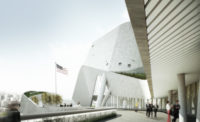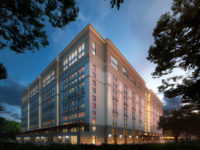“I don’t like his uniform,” said a world-renowned architect, dressed in khakis and a polo shirt, during a poolside conversation in Miami. “But I’m sure he doesn’t like mine either.”
The he is Peter Marino, a prolific architect who is best known, these days, for showing up in public in full leather drag, with tattoos on his exposed arms and a Mohawk underneath his leather biker cap. Famous for designing houses for socialites, as well as stores for Chanel, Louis Vuitton, Dior, and other luxury brands, Marino seems to want to shock his conservative clientele with his appearance.
But people aren’t easily shocked these days, so Marino has enlisted the Bass Museum in Miami Beach in a vast vanity project, an exhibition of works by, for, and about Marino, presented in rooms that suggest dungeons presided over by a very self-important dragon (and sponsored in part by Chanel, Louis Vuitton, and Dior). Setting the tone is a Gregor Hildebrandt portrait of Marino on the outside of the building; it is mounted on a black background made from unspooled videotapes of interviews with you-know-who. Not self-referential enough? Adorning one of the men’s rooms is a large photo of Marino, facing a wall, legs spread, as if relieving himself. The show is called Peter Marino: One Way. Clearly, the one way is his way.
Large galleries are devoted to portraits of Marino, including a wax-museum-style figure so lifelike that people thought the man himself was lurking in a corner. (A painting on velvet wouldn’t be out of place here.) In other rooms, artworks from Marino’s personal collection fill every inch of wallspace; the extreme crowding makes it impossible to appreciate anything but the architect’s acquisitiveness. (Terrific artists like Vik Muniz are lost in the visual cacophony.) Yet another room, its walls covered in leather, contains a series of bronze cabinets designed by Marino, reminiscent of the work of Paul Evans, but less interesting. There’s also a gallery filled with skulls, and an even larger space devoted to an opera performed, yes, in Marino’s house. One of the smallest rooms is devoted to Marino’s architecture. To fit hundreds of projects into that space, the architect and curator Jerome Sans opted for flat-screen TVs that cycle though photos of Marino buildings.
But the problem with the show isn’t that it’s chaotic and excessive—it’s that it doesn’t do the one thing it promised to do, which is explore the relationship between Marino (who studied at Cornell and apprenticed for SOM and I.M. Pei) and his architecture. Marino’s buildings are generally innocuous, while Marino is in-your-face; the show does nothing to explain the contradiction. As the architect moved through the galleries on Wednesday with socialite clients in tow, I asked him to name the building he is proudest of. He responded, “The building I did for Samsung in Korea.” “Why,” I asked? “Because it’s marble on the outside and concrete on the inside”—smooth containing rough. Not quite a key to this complex man, but something.
Rem Koolhaas may have a big ego, but compared to Marino he is self-effacing. Koolhaas and his New York partner Shohei Shigematsu have designed a cultural center, called the Faena Forum, for a hotel and condo complex that the Argentinian developer Alan Faena is building on a six-acre swath of Miami Beach. A small museum on Faena’s property is devoted to a show about how OMA arrived at its design. To create the Forum, which will contain a concert hall connected to a black box gallery/theater, the architects looked to examples from antiquity—surprisingly for Koolhaas’s firm, there’s a strong resemblance to the Pantheon. Koolhaas and Shigematsu played with shapes and sizes (at one point, the building resembled a fez), eventually grafting the round hall onto the rectangular one, and covering the whole thing in a geometrically compelling concrete skin. Compared to OMA’s Casa da Musica in Porto, completed in 2005, the building is loose and flowing. And, despite its presence in what it essentially a sales office, the exhibition has more to say than the Marino extravaganza. Who's to say what's culture and what's commerce?








